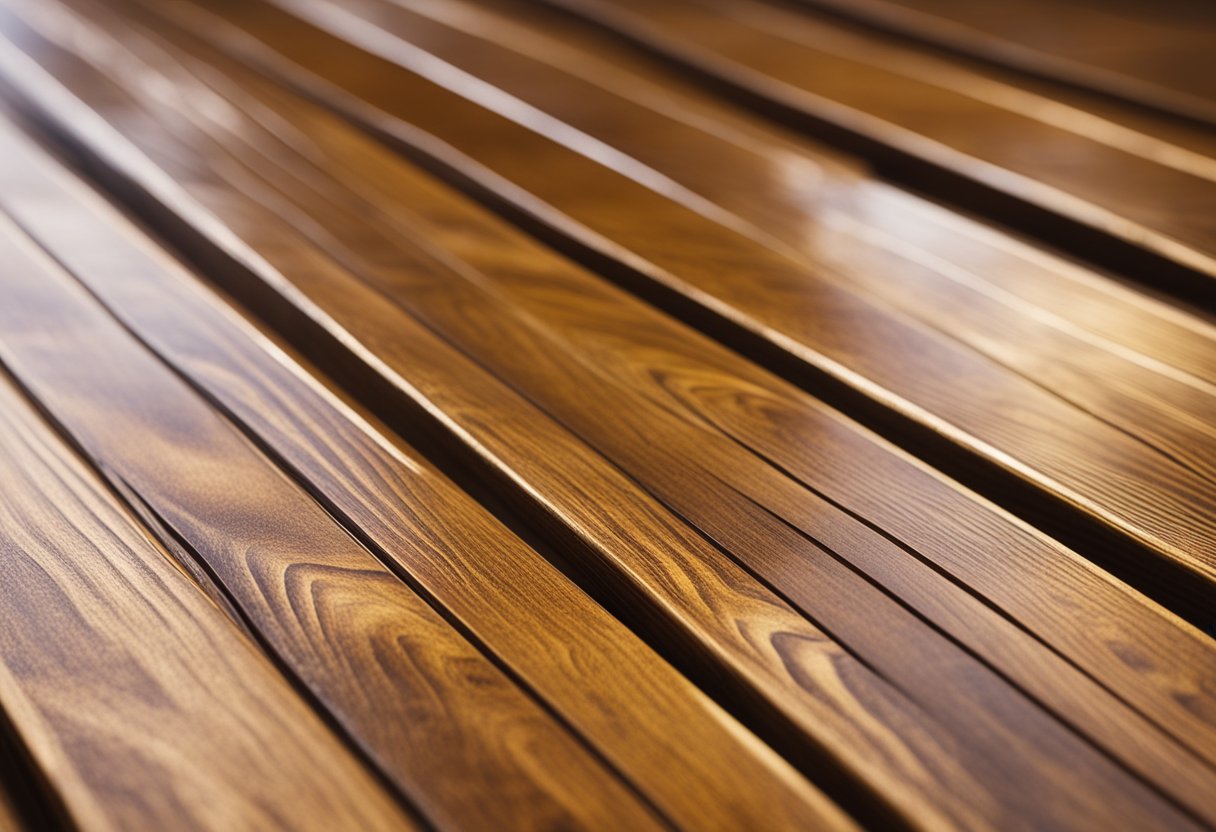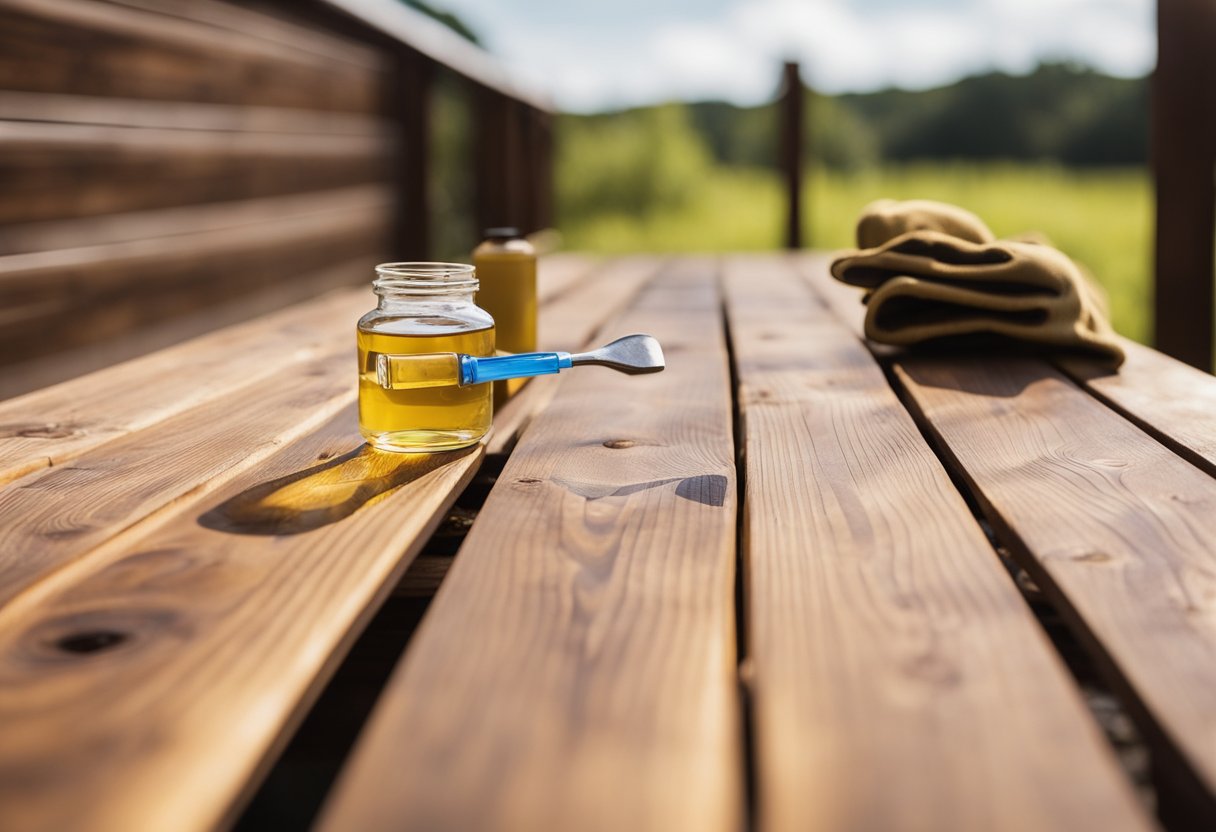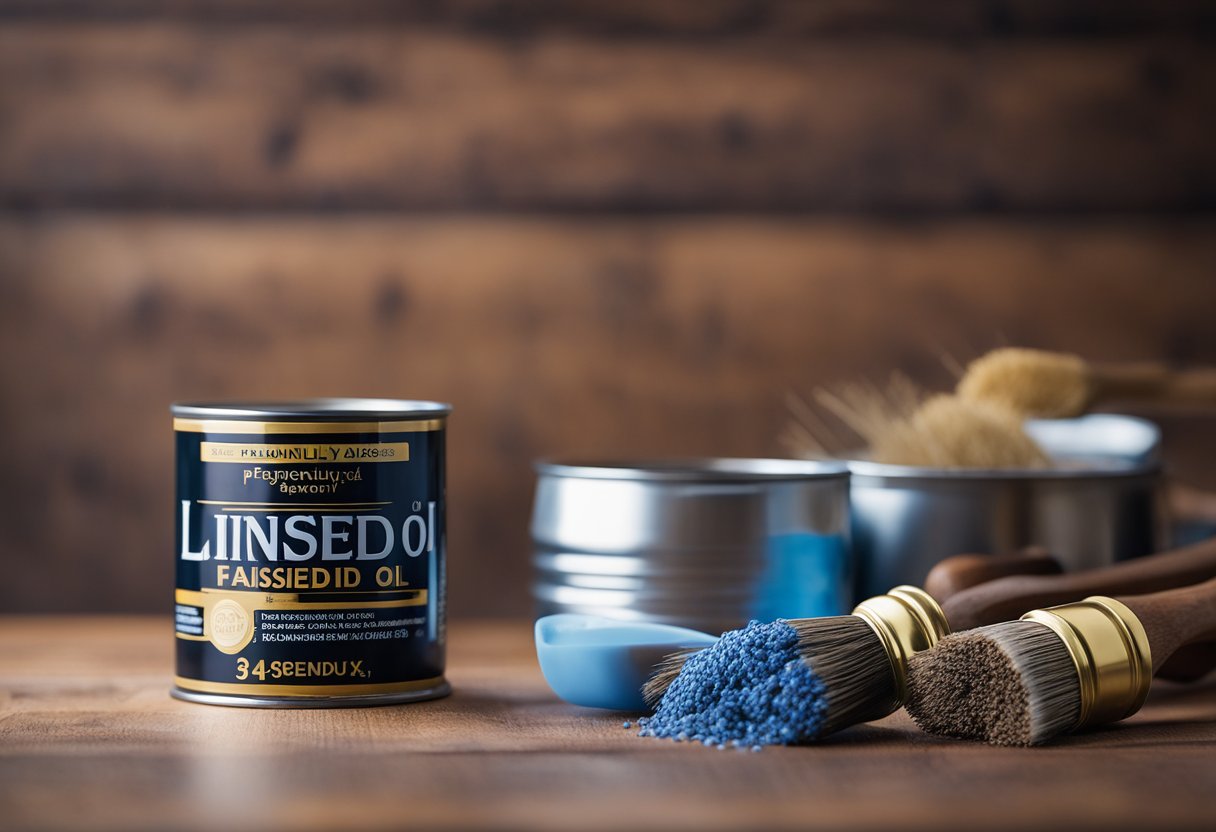Linseed oil is a popular choice for finishing decks, thanks to its natural properties and ability to enhance the appearance of the wood. However, before applying linseed oil to your deck, it’s important to understand its benefits, drawbacks, and the proper application process. In this article, I will share my knowledge and expertise on using linseed oil on decks, including how to prepare your deck for application, the components and mixing ratios of linseed oil, and maintenance tips.

Understanding linseed oil is the first step to using it on your deck. Linseed oil is a natural oil extracted from flaxseed and is commonly used as a wood finish due to its ability to penetrate deep into the wood fibers, providing protection against moisture and decay. When applied to a deck, linseed oil enhances the natural grain of the wood, leaving a wet look on the surface. However, it’s important to note that linseed oil takes longer to dry than other deck finishes and requires proper preparation and application to achieve optimal results.
To prepare your deck for linseed oil application, you should start by cleaning and removing any dirt, debris, or old finishes. After cleaning, allow the deck to dry completely before applying the linseed oil. When it comes to the application process, it’s important to use the right components and mixing ratios to achieve the desired results. This includes using a lint-free towel or brush to apply the linseed oil, and mixing it with a solvent such as mineral spirits to help it penetrate deeper into the wood.
Key Takeaways
- Linseed oil is a natural oil extracted from flaxseed that enhances the natural grain of wood and provides protection against moisture and decay.
- Proper preparation and application of linseed oil is crucial to achieving optimal results on your deck.
- Maintenance and reapplication of linseed oil is necessary to ensure long-lasting protection and enhanced appearance of your deck.
Understanding Linseed Oil
As a woodworking enthusiast, I have come across linseed oil several times, and it’s a product that I always recommend to anyone looking to finish their deck. Linseed oil is a natural oil extracted from the seeds of flax plants, and it has been used for centuries as a wood finish and preservative.
There are two types of linseed oil: raw and boiled. Raw linseed oil is the purest form of linseed oil, and it takes a long time to dry. On the other hand, boiled linseed oil has been treated with additives to make it dry faster. Boiled linseed oil is the most commonly used linseed oil for deck finishing, as it dries faster and provides a more durable finish.
Linseed oil is a natural oil that penetrates deep into the wood, creating a moisture-resistant barrier that will not crack over time like paint will. It enhances the natural beauty of the wood, making the grain appear prominently, leaving a wet look on your deck.
Another type of linseed oil is polymerized linseed oil. Polymerized linseed oil is boiled linseed oil that has been treated with heat and chemicals to make it dry faster and provide a more durable finish. It is more expensive than boiled linseed oil, but it provides a harder and more water-resistant finish.
Linseed oil has many properties that make it an ideal wood finish. It is non-toxic, easy to apply, and it does not require any special equipment. It is also resistant to water, mildew, and insects, making it an excellent choice for outdoor use.
In conclusion, linseed oil is a natural oil that has been used for centuries as a wood finish and preservative. Boiled linseed oil is the most commonly used linseed oil for deck finishing, as it dries faster and provides a more durable finish. Polymerized linseed oil is a more expensive but harder and more water-resistant finish. Linseed oil is an excellent choice for outdoor use, as it is non-toxic, easy to apply, and resistant to water, mildew, and insects.
Preparation of Deck for Application

Before applying linseed oil on a deck, it is essential to prepare the deck surface adequately. Proper preparation ensures that the oil penetrates deeply into the wood grain, enhancing the natural beauty of the wood and providing protection against weathering. Here are the steps to follow when preparing a deck for linseed oil application:
-
Clean the deck surface: Use a broom to sweep the deck surface and remove any debris, leaves, or dirt. If the deck has stains, you can use hot, soapy water and a brush to remove them. For tough stains, use deck cleaners that are safe for wood. Rinse the deck surface with clean water and allow it to dry completely.
-
Sand the deck surface: Sand the deck surface to remove any rough spots and splinters. Sanding also opens the wood pores, allowing the linseed oil to penetrate deeply into the wood grain. Use a power sander or a sandpaper with a grit of 80-100 for best results.
-
Inspect the deck surface: Inspect the deck surface for any loose boards, nails, or screws. Tighten any loose boards and replace any damaged ones. Hammer in any protruding nails or screws and replace any missing ones.
-
Protect surrounding areas: Cover any surrounding areas, such as plants or furniture, with plastic sheets or drop cloths to protect them from linseed oil drips or spills.
By following these steps, you can ensure that your deck is adequately prepared for linseed oil application. Proper preparation ensures that the oil penetrates deeply into the wood grain, enhancing the natural beauty of the wood and providing protection against weathering.
Application Process of Linseed Oil
I have found that applying linseed oil on a deck is a straightforward process that can be done with a few tools and some patience. Before starting, I recommend checking the temperature and humidity to ensure that the conditions are ideal for the oil to dry correctly. You should also wear gloves, preferably rubber gloves, during the application process.
The first step is to clean the deck thoroughly to remove any dirt, debris, or old finishes. I usually sweep the surface of the deck with a broom, and if necessary, I use a power washer to remove stubborn stains. After cleaning, I let the deck dry completely before proceeding to the next step.
Next, I apply the linseed oil using a brush or a rag. I prefer using a brush as it allows me to apply the oil evenly and penetrate deeply into the wood grain. I pour the linseed oil into a paint tray and dip the brush into the oil. Then, I apply the oil in long strokes, following the direction of the wood grain.
After applying the first coat, I let it dry for 24-48 hours, depending on the temperature and humidity. If necessary, I apply a second coat, following the same process as the first coat. I find that two coats are usually enough to achieve the desired finish.
It is essential to dispose of any rags or brushes used to apply the linseed oil carefully. The oil can self-ignite and cause a fire, so I usually soak the rags or brushes in water before disposing of them.
Overall, the application process of linseed oil on a deck is relatively simple and can be done by anyone with some basic tools and knowledge. With proper application, linseed oil can penetrate deeply into the wood grain, providing long-lasting protection against scratches and the effects of weathering.
Components and Mixing Ratios

When it comes to using linseed oil on decks, it is important to understand the components and mixing ratios involved. Linseed oil is a natural oil that is derived from flax seeds, and it is a popular choice for finishing and protecting wood surfaces such as decks.
One of the most important components to consider when using linseed oil on a deck is the solvent. Turpentine and mineral spirits are common solvents used to thin linseed oil and make it easier to apply. The ratio of linseed oil to solvent can vary depending on the desired finish and the type of wood being treated.
A common mixing ratio for linseed oil and turpentine is 1:2. This ratio helps to prevent the turpentine from being too sticky and allows the linseed oil to penetrate the wood more effectively. However, it is important to note that the exact ratio may vary depending on the specific product being used and the conditions in which it is being applied.
When mixing linseed oil and solvent, it is important to do so in a well-ventilated area and to follow the manufacturer’s instructions carefully. It is also important to use the correct tools, such as a clean container and a stir stick, to ensure that the mixture is well blended.
In conclusion, understanding the components and mixing ratios involved in using linseed oil on a deck is essential for achieving a high-quality finish that will protect the wood and enhance its natural beauty. By following the guidelines outlined above, you can ensure that your linseed oil application is effective and long-lasting.
Benefits and Drawbacks of Linseed Oil on Decks
As someone who has used linseed oil on decks, I can confidently say that it has both advantages and disadvantages.
Advantages
Protection and Seal
Linseed oil is a great option for those looking to protect their deck from weather elements, moisture, and rot. It penetrates deep into the wood grain, creating a seal that protects the deck from water damage.
Natural Color
Linseed oil can enhance the natural color of the wood, giving it a warm, rich tone. It also brings out the natural grain of the wood, making it look more attractive.
UV Protection
Linseed oil provides some UV protection, which can help prevent the wood from fading or turning gray over time.
Aesthetic Appeal
Linseed oil gives the deck a natural and rustic look that many people find appealing. It can also be used to create a glossy or matte finish, depending on the user’s preference.
Disadvantages
Weather Protection
While linseed oil provides some weather protection, it is not as effective as other deck finishes like varnish or paint. It may need to be reapplied more frequently to maintain its protective qualities.
Drying Time
Linseed oil can take a long time to dry, which can be frustrating for those who want to use their deck immediately after applying the oil.
Fire Hazard
Linseed oil is flammable and can be a fire hazard if not used properly. Rags and other materials used to apply the oil should be disposed of carefully to avoid the risk of spontaneous combustion.
Maintenance
Linseed oil requires regular maintenance to keep the deck looking good and to maintain its protective qualities. This may include regular cleaning and reapplication of the oil.
Overall, linseed oil is a good option for those looking for a natural and rustic look for their deck. However, it may not be the best choice for those looking for maximum weather protection or minimal maintenance.
Maintenance and Reapplication
Maintaining a deck finished with linseed oil is relatively easy but requires regular application to keep the wood protected from weathering and other factors. I recommend reapplying linseed oil to your deck every year or two, depending on your climate and weathering.
Before reapplication, it is important to clean the deck thoroughly and let it dry completely. Any dirt or debris left on the deck can interfere with the oil’s ability to penetrate the wood. Once the deck is clean and dry, test the wood’s absorbency by sprinkling a few drops of water on the surface. If the water beads up, the deck is not ready for reapplication. If the water is absorbed, the deck is ready to be oiled.
When applying linseed oil, make sure to apply it evenly and avoid leaving any puddles or excessive amounts of oil. Wipe off excess oil within a few minutes of applying it to prevent a sticky deck. Allow the oil to penetrate for 30 minutes, then wipe off any excess oil. Let it dry for 24-48 hours before using the deck.
Factors such as weathering and climate can affect the drying time of linseed oil. In humid climates, the drying time may be longer, and the oil may not fully dry for several days. It is important to avoid using the deck until the oil has fully dried to prevent any damage to the finish.
Regular application of linseed oil can help protect your deck from weathering and other factors that can damage the wood. By following these maintenance and reapplication tips, you can keep your deck looking beautiful and protected for years to come.
Alternatives to Linseed Oil
While linseed oil is a popular choice for deck finishes, it may not be the best option for everyone. Here are a few alternatives to consider:
Acrylic
Acrylic finishes are a popular choice for those who want a clear, water-resistant finish that won’t yellow over time. They are also easy to apply and clean up with soap and water. However, they do not penetrate the wood as deeply as oil-based finishes, which can lead to less protection against weathering and scratches.
Tung Oil
Tung oil is another natural oil finish that provides a water-resistant seal and a natural-looking finish. It is easy to apply and dries quickly, but it may require multiple coats to achieve the desired level of protection. Tung oil is also more expensive than linseed oil.
Oil-Based Finishes
Oil-based finishes, such as varnish and polyurethane, are durable and provide excellent protection against weathering and scratches. They are also available in a range of colors and finishes, from matte to high gloss. However, they can be more difficult to apply and clean up than other finishes.
Danish Oil
Danish oil is a blend of natural oils and varnish that provides a water-resistant seal and a natural-looking finish. It is easy to apply and dries quickly, but it may require multiple coats to achieve the desired level of protection. Danish oil is also more expensive than linseed oil.
Deck Stain
Deck stain is a popular choice for those who want to add color to their deck while also providing protection against weathering and scratches. Stains are available in a range of colors and finishes, from transparent to solid. However, they do not provide as much protection as other finishes and may need to be reapplied more frequently.
Ultimately, the best choice for your deck will depend on your personal preferences and the specific needs of your deck. Consider factors such as the level of protection you need, the look you want to achieve, and the ease of application and cleanup when choosing a finish for your deck.
Safety Measures and Tips

As with any DIY project, safety should be a top priority when using linseed oil on your deck. Here are some safety measures and tips to keep in mind:
- Protective gear: Always wear gloves, preferably rubber gloves, to protect your skin from the oil. Linseed oil can cause skin irritation and allergic reactions in some people, so it’s better to be safe than sorry.
- Ventilation: Work in a well-ventilated area to avoid inhaling fumes. Open windows and doors to increase airflow, and wear a mask if necessary.
- Dietary Supplement: Did you know that linseed oil is also available as a dietary supplement? While it has many health benefits, it’s important to note that the oil used on decks is not food grade and should not be ingested.
- Lint-free towel: Use a lint-free towel to wipe away excess oil and prevent dry spots.
- Dry spots: If you notice any dry spots on your deck after applying the oil, simply apply more oil to those areas and buff with a clean towel.
- Buff: Buffing the deck after applying the oil can help distribute the oil evenly and create a smooth finish.
By following these safety measures and tips, you can ensure a successful and safe linseed oil application on your deck.
Frequently Asked Questions

What is the best oil to use for outdoor decking?
There are many oils that can be used for outdoor decking, but linseed oil is one of the best options. Linseed oil is a natural oil that penetrates deep into the wood, providing long-lasting protection against weather damage.
What is double boiled linseed oil and can it be used on decks?
Double boiled linseed oil is a type of linseed oil that has been heated to remove impurities and speed up the drying process. It can be used on decks, but it is not necessary. Regular linseed oil is sufficient for most decks.
Is deck sealer necessary when using linseed oil on a deck?
Deck sealer is not necessary when using linseed oil on a deck, but it can provide additional protection against weather damage and UV rays. If you choose to use a deck sealer, make sure it is compatible with linseed oil.
Can linseed oil be used on redwood decks?
Yes, linseed oil can be used on redwood decks. Redwood is a naturally durable wood, but linseed oil can help protect it from weather damage and UV rays.
How long does it take for linseed oil to dry on an outdoor deck?
The drying time for linseed oil on an outdoor deck can vary depending on the temperature and humidity. Generally, it takes about 24-48 hours for linseed oil to dry completely.
Will linseed oil protect outdoor wood from weather damage?
Yes, linseed oil can protect outdoor wood from weather damage. It penetrates deep into the wood, providing long-lasting protection against water, sun, and other weather elements. However, it is important to reapply linseed oil every few years to maintain its effectiveness.

Hi, I’m Sal Muller of Tooltrip.com. My DIY experience led me to understand essential power tools for home projects. Tooltrip.com guides enthusiasts and professionals in choosing right tools for any job. I provide concise top tool reviews for easier, efficient DIY.

